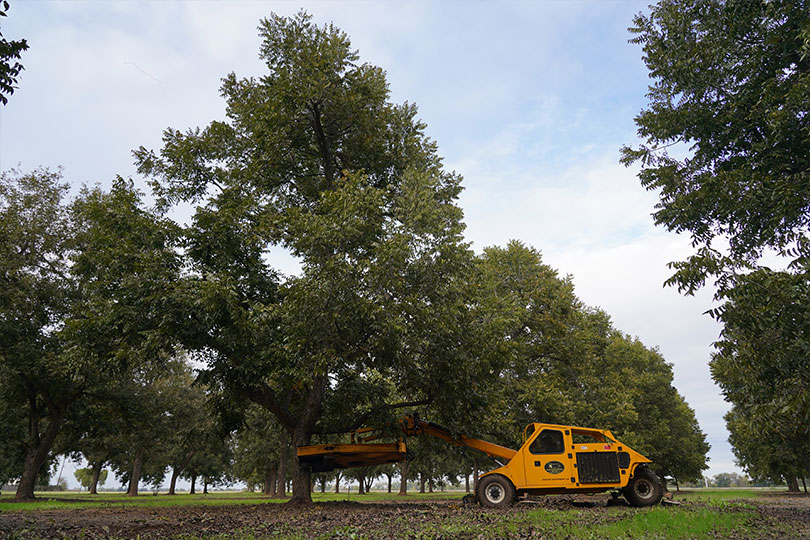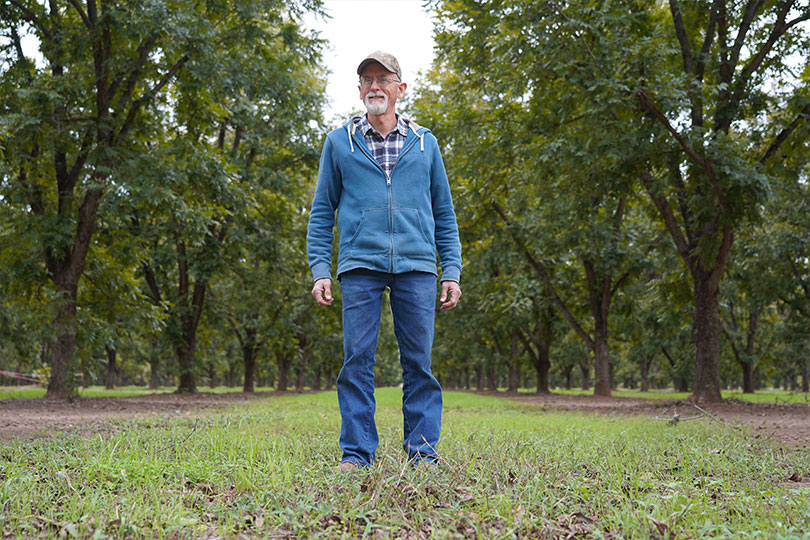By Julie Tomascik
Editor
Crack open the shell of a pecan, and you’ll find a story of the state’s economy, agriculture and history.
And it’s a story that began in 1985 for Royalty Pecan Farms near Caldwell where about 13,000 trees are growing on 500 acres.
You’ll find Andy Sherrod managing the orchard, caring for the trees and harvesting the fruits of their labor.
“This was a cotton field before it became a pecan orchard. And then back in the late ’70s and early ’80s, about a five-year span, the previous owners came in and planted this orchard, and it’s been established since that time,” Sherrod said.
They grow six different varieties—Wichita, Cheyenne, Choctaw, Kiowa, Desirable and GraCross.
Growing and harvesting
Growing pecans is a year-round process.
“There’s something happening here in the orchard every single month. Beginning in April at bud break, the leaves come out. The flowers come out. The crop is set,” he said. “We protect it against insects and disease. We manage the orchard floor. We supply enough water and nutrients to keep the trees healthy for the following six months.”
Then in October and November, when the green shucks split open and the nut is exposed, harvest begins.
For Sherrod and Royalty Pecan Farms, that continues through the end of the year and into January.
It takes several pieces of equipment to gather the crop, process it and get it ready for sale.
Harvest begins with the shaker removing the crop from the trees mechanically. The shaker grabs the trunk about waist high and gives it a good shake. And the crop falls to the ground.
The shaker head is designed with a rubber pad and rubber flap so as not to damage the trees during the process, Sherrod noted.
“Then, we have tractor mounted sweeper blowers that come through and create these long windrows, sweeping everything on the ground into one long row between the tree rows,” he said.
After that, a machine comes back and removes the leaves to reveal the crop for the harvester to pick up. Soil and other debris are blown back into the field, and everything heavy is retained in the harvester as it moves through the orchard.
They take the pecans to their processing facility where a series of blowers and screens separate out the orchard trash from the saleable pecans. The pecans go through a chlorine bath to sanitize them, and then they go into a dryer to remove the surface moisture from the sanitation process, but more importantly, the kernel moisture.
Once that process is complete, the pecans go across an inspection table.
“They’re visually inspected. Any imperfections or anything that’s mixed in with the saleable nuts is removed,” Sherrod said. “And then they’re sized into large, medium and small and bagged into 50-pound bags or 2,000-pound super sacks.”
After harvest is completed in January, the trees go dormant.
“That’s when we come in with our hedger mechanical limb cutter and create open spaces between the trees so that sunlight can then penetrate the canopy in the summertime for the photosynthesis process to take place,” Sherrod said.

Pecan production
Pecans are a unique crop when it comes to production. They typically go through a cyclical performance year to year.
“They put on a big crop one year and a light crop the next,” he said. “In our off year, we hope it’s a good off year. The heavy year sometimes can be too heavy. So, we’ll go in the summer with our shaker and remove a portion of that crop, so it doesn’t stress the tree. The quality of that crop is increased and then the potential for it to come back the following year with a good off year is increased.”
Pecan trees can produce anywhere from 30 pounds to 100 pounds per tree. It all depends on the variety and growing conditions.
Holiday market
Texans have a love for pecans, and pecan farmers aim to deliver.
Pecan products are available at Royalty Pecan Farms’ retail store. They sell a variety of flavored pecans made in their farm kitchen. But they also have several other items available for purchase, including raw pecans, pecan coffee, pecan oil, pecan pies and pecan butter.
“We produce a whole lot of pecan pies, especially in the holiday season. And there’s pecan bread,” he said. “A great many things come out of that kitchen that are really tasty.”
They have a lot of traffic in their store, but their online sales are growing, too.
“What’s unique about this particular crop is that we can go straight to the consumer, unlike cotton and some of the other row crops,” Sherrod said. “We get to see the fruit of our labor go into the hands of a customer as they walk out the door and be pleased that they have something of high quality they can enjoy with their family.”

Texas pecans
Pecan trees are native to Central Texas. They fuel the economy and are a rich part of the state’s agriculture and history.
“In this area, they grow wild along the creeks and rivers, and it’s an ideal soil,” he said. “This is a river bottom flood plain, alluvial type soil. It’s deep. It’s well-drained, and yet it has a very high water holding capacity. Pecan trees just love this type of soil.”
And pecans are a symbol of state pride. Two official state symbols include the Lone Star favorite—the state tree and the state pie.
They’re in demand, too. Domestic demand for pecans is stronger this year, and export demand from other countries, including Mexico, South Africa and South American nations, filled some of the gap the trade war with China created for U.S. pecan growers.
Those markets are important to keep pecans moving to consumers both near and far from the Lone Star State, which currently ranks third in pecan production behind Georgia and New Mexico.
Each crop brings challenges and excitement through the year, but there’s no doubt the most enjoyable part of the harvest is the satisfaction of a job well done.
Pecan growers take pride in being associated with Lone Star State symbols and growing a crop that folks truly enjoy, sharing their pecan passion with Texans across the state.

